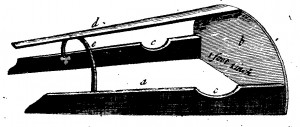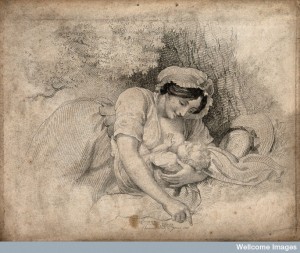By Lisa Smith (Regular Contributor)
Parents of infants are obsessed with sleep. Is the baby a good sleeper? Will the parents ever sleep again? But in particular, the spectre of SIDS (Sudden Infant Death Syndrome) haunts all new parents… causing panic when the baby finally does sleep through the night. Although the campaign to have babies sleep on their backs has led to a significant decline in cases since the 1990s, a more controversial recommendation by many health authorities is that parents not sleep with their infants to prevent suffocation or over-heating; but if they do, the bed should be firm and free of pillows and heavy bedding. Supporters often discuss bed-sharing as a natural activity or the historical norm, but the debate over bed-sharing—and the discourse of what is natural—goes back a long way.
By the mid-seventeenth century, the Bills of Mortality tallied the weekly causes of death in London. One classification was “overlaying”, which referred to the wetnurse or mother rolling on to a sleeping baby or the baby suffocating under the bedclothes. The numbers did not remain constant. To give just two examples: in one November week in 1719, there were no overlaying deaths, but in one December week in 1726, there were sixty-seven.
By 1731, there was a growing interest in preventing these deaths. Oliver St. John wrote to the Philosophical Transactions with a suggestion:
When I consider how many are charged overlaid in the Bills of Mortality, I wonder that the Arcutio’s, universally used at Florence, are not used in England. This would prevent infants from being smothered by bedclothes, even if they were completely covered over.
The device even had hollows for the nurse’s breasts, allowing her to breastfeed (c). Resting on a bar of wood (d) would keep her from falling onto the child and provide support. The arcutio could safely allow nurses and mothers to follow their natural preference to breastfeed in bed.
According to St. John, every nurse in Florence was obliged to use one, under pain of excommunication. This assertion was corrected in an article on “The Arcuccio” in the British Medical Journal (10 August 1895). Italian priests did encourage their parishioners to use the devices, the author wrote, but “the use of the arcuccio is enforced partly by public opinion, which would judge very severely any mother whose child lost its life owing to failure to use a well recognised precaution.” Perhaps in an attempt to build up similar public support in England, St. John’s article was soon after reprinted as general advice towared the end of The Art of Nursing (1733).
Discussions of the arcutio as a solution largely disappeared until the nineteenth century, although it made an appearance in John Jones’ Medical, Philosophical and Vulgar Errors, of Various Kinds, Considered and Refuted (1797). Jones addressed the question of whether a white mother in the West Indies “must shew a great want of Affection” to let her child be suckled by a black wetnurse on the grounds that the nurse’s milk would be of poor quality. Jones believed that black wetnurses had excellent milk, but he suggested that because “they are more careless and less affectionate than the white,” they should always be encouraged to use arcutios.
Authors of eighteenth-century infant-rearing manuals provided contradictory advice about the threat of overlaying. In The Nurses Guide (1744), Thomas Dawkes insisted that infants should never sleep in the same bed as the mother or nurse “for fear of overlaying it, (a caution, I am afraid, not so often observ’d as ought to be).” Clearly many women continued to sleep with their babies rather than put them in cradles.
William Moss was an adamant supporter. In his Essay on the Management and Nursing of Children (1781), he claimed that young babies needed the warmth of “a common bed” for health and development, especially in the cold northern climate. That young children “will frequently make surprising efforts and attempts, when in bed with the nurse, to get near her” surely meant “it can be no other than an instinctive requisite, [which] ought to be indulged.” He dismissed the fear of overlaying:
if she has been accustomed to sleep with children; and is an accident that scarcely happens once in an age with those who have not been accustomed.
Moss contradicted the contemporary medical focus on strengthening constitutions by cold-bathing and exposure to cold air, but his advice tapped into the widespread midwifery practice of keeping new mothers and babies warm, as well as the eighteenth-century belief that nature always knew best.
The question of “natural” practices has long been at the centre of debates on bed-sharing. For Moss, overlaying rarely happened because bed-sharing was so natural: babies instinctively snuggled for heat and carers managed to avoid rolling on them. The arcutio was depicted as a useful device both in terms of overcoming nature (the carelessness of black wetnurses, according to Jones) and aiding it (ordinary breast-feeding behaviour, according to St. John). As the concern over saving babies the arcutio way reveals, although bed-sharing was a historical norm, the desirability of following one’s nature was no more clear than it is today.


